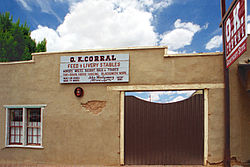- Inside Schieffelin's silver mine
- Tombstone City Hall
- The O.K. Corral, Allen Street entrance
- The Tombstone Epitaph building
- Balcony inside the Bird Cage Theatre
- Gambling parlor in the basement of the Bird Cage Theatre
- The Crystal Palace
- The Bucket of Blood Saloon
- The Oriental Saloon
- Big Nose Kate's Saloon
- The Sacred Heart Church Parish
- The Bella Union Saloon and Opera House
- The Allen English house
- The Silver Nugget Bed and Breakfast
- The Can Can Restaurant
- The William Herring building
- Vogan's Alley Bar and Grill
- Fly's Photography Gallery
- The Territorial Drug Co – Tombstone Pharmacy – 1898.
List of historic properties in Tombstone, Arizona | |
|---|---|
 Historic Allen Street | |
 Location in Cochise County and the state of Arizona |
| Part of a series of the |
| Cities, towns and CDPs in Arizona with lists and images of historic properties, forts, cemeteries or historic districts |
|---|
This is a list of historic properties in Tombstone, Arizona, which includes a photographic gallery of some of the remaining historic structures. The majority of these structures are in the Tombstone Historic District which was declared a National Historic Landmark in 1961. The district was added to the National Register of Historic Places (NRHP) on October 15, 1966. The gallery includes the Sacred Heart Church, St. Paul's Episcopal Church, the Tombstone City Hall, and the Tombstone Courthouse, among many other historic structures. The historic Boot Hill Graveyard is also included here, with images of the graves of some of the town's notable internees; however, the graveyard was specifically excluded from the NRHP historic district due to its lack of historic integrity. [1]









































